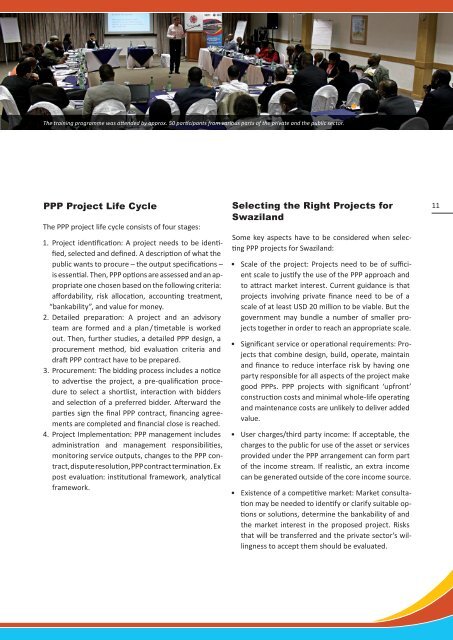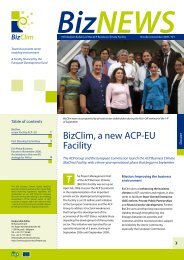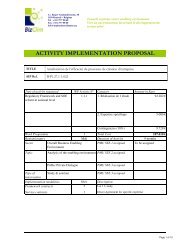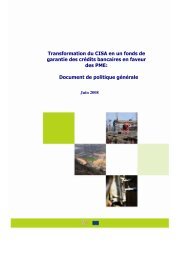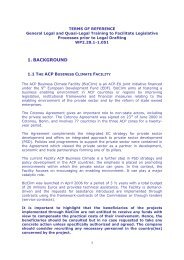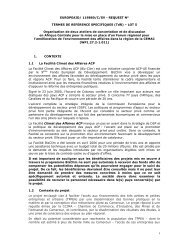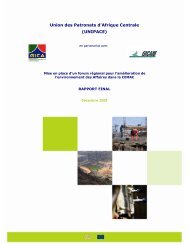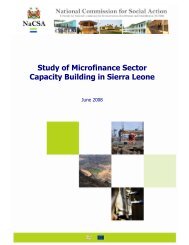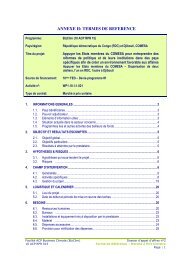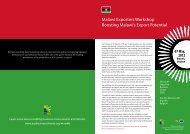(PPP) for Swaziland - ACP Business Climate
(PPP) for Swaziland - ACP Business Climate
(PPP) for Swaziland - ACP Business Climate
You also want an ePaper? Increase the reach of your titles
YUMPU automatically turns print PDFs into web optimized ePapers that Google loves.
The training programme was attended by approx. 50 participants from various parts of the private and the public sector.<br />
<strong>PPP</strong> Project Life Cycle<br />
The <strong>PPP</strong> project life cycle consists of four stages:<br />
1. Project identification: A project needs to be identified,<br />
selected and defined. A description of what the<br />
public wants to procure – the output specifications –<br />
is essential. Then, <strong>PPP</strong> options are assessed and an appropriate<br />
one chosen based on the following criteria:<br />
af<strong>for</strong>dability, risk allocation, accounting treatment,<br />
“bankability”, and value <strong>for</strong> money.<br />
2. Detailed preparation: A project and an advisory<br />
team are <strong>for</strong>med and a plan / timetable is worked<br />
out. Then, further studies, a detailed <strong>PPP</strong> design, a<br />
procurement method, bid evaluation criteria and<br />
draft <strong>PPP</strong> contract have to be prepared.<br />
3. Procurement: The bidding process includes a notice<br />
to advertise the project, a pre-qualification procedure<br />
to select a shortlist, interaction with bidders<br />
and selection of a preferred bidder. Afterward the<br />
parties sign the final <strong>PPP</strong> contract, financing agreements<br />
are completed and financial close is reached.<br />
4. Project Implementation: <strong>PPP</strong> management includes<br />
administration and management responsibilities,<br />
monitoring service outputs, changes to the <strong>PPP</strong> contract,<br />
dispute resolution, <strong>PPP</strong> contract termination. Ex<br />
post evaluation: institutional framework, analytical<br />
framework.<br />
Selecting the Right Projects <strong>for</strong><br />
<strong>Swaziland</strong><br />
Some key aspects have to be considered when selecting<br />
<strong>PPP</strong> projects <strong>for</strong> <strong>Swaziland</strong>:<br />
• Scale of the project: Projects need to be of sufficient<br />
scale to justify the use of the <strong>PPP</strong> approach and<br />
to attract market interest. Current guidance is that<br />
projects involving private finance need to be of a<br />
scale of at least USD 20 million to be viable. But the<br />
government may bundle a number of smaller projects<br />
together in order to reach an appropriate scale.<br />
• Significant service or operational requirements: Projects<br />
that combine design, build, operate, maintain<br />
and finance to reduce interface risk by having one<br />
party responsible <strong>for</strong> all aspects of the project make<br />
good <strong>PPP</strong>s. <strong>PPP</strong> projects with significant ‘upfront’<br />
construction costs and minimal whole-life operating<br />
and maintenance costs are unlikely to deliver added<br />
value.<br />
• User charges/third party income: If acceptable, the<br />
charges to the public <strong>for</strong> use of the asset or services<br />
provided under the <strong>PPP</strong> arrangement can <strong>for</strong>m part<br />
of the income stream. If realistic, an extra income<br />
can be generated outside of the core income source.<br />
• Existence of a competitive market: Market consultation<br />
may be needed to identify or clarify suitable options<br />
or solutions, determine the bankability of and<br />
the market interest in the proposed project. Risks<br />
that will be transferred and the private sector’s willingness<br />
to accept them should be evaluated.<br />
11


